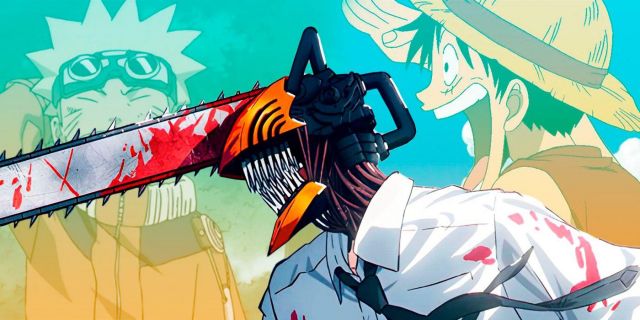Author Tatsuki Fujimoto’s masterpiece manga Chainsaw Man has quickly become a shonen staple, especially with its ultra-popular anime of the same name. Curiously, Chainsaw Man is both a tried-and-true shonen action story and a gleeful deconstruction of what shonen is supposed to be, making it a product of its time.
In the current era, shonen manga and anime is more diverse than ever, including cross-pollination with the shojo world, such as Horimiya and Komi Can’t Communicate. Shonen has long since established its modern voice, so now is the time to tinker with the formula and explore what-ifs and deconstructions, such as with Chainsaw Man. Doing that during the height of the shonen “big three,” however, would have been a mistake.
Why Chainsaw Man Would Have Struggled Against the Original Big Three

The classic big three are retroactively recognized as being Eiichiro Oda’s One Piece, launching in 1997, Masashi Kishimoto’s Naruto, which made its debut in 1999, and Tite Kubo’s Bleach, which completed the trio when it started serialization in 2001. At the time, these three shonen juggernauts dominated the field in terms of popularity, exposure and more objectively, manga volume sales, even overshadowing other hard-hitting titles like Hunter x Hunter, D.Gray-Man and Fullmetal Alchemist.
In that era, spanning the late 1990s to the mid-2010s, these three giants helped define shonen after older titles like Dragon Ball, Yu Yu Hakusho and Slam Dunk were finished. Shonen was, with some exceptions, an optimistic, energetic demographic where the power of friendship, aggressive power scaling, good-natured comedy and positive messages prevailed. It was a time of good feelings and strong, clean heroes like Monkey D. Luffy and Edward Elric.
Chainsaw Man aims to deconstruct such things with storytelling elements like extreme blood and gore, a dismal tone of misery and death and certainly antiheroes like the pervy Denji and his fiendish partner Power. For today’s manga and anime fans, Chainsaw Man is a delightful and refreshing break from the shonen formula, but this would have clashed too much with the big three and their competitors in the late 1990s and 2000s.
Those series set the standard and the tone for shonen, and Chainsaw Man would have felt weirdly out of place. It would have been too much of a rebel, harshly defying and mocking what made the big three so great, and shonen fans might not have liked that. It would have been a case of “Read the room, Chainsaw Man! This is an era of hope and happiness!”
Why Chainsaw Man’s Ideas Had to Wait to Be Relevant

Chainsaw Man has a lot to offer, so it’s only a question of when, not whether, shonen fans want to read and watch what Chainsaw Man is all about. During the big three’s heyday, shonen manga and anime was a bit more monolithic, staying true to its core idea of “straightforward action and comedy for boys.” Over time, especially from the late 2010s, shonen started to branch out and borrow ideas from shojo and seinen to great effect, and it paid off with titles like Komi Can’t Communicate and Chainsaw Man.
Shonen may have done this in earlier years, but in that later era in particular, fans got used to shonen titles being more than Dragon Ball clones. Now, the demographic has its foot in the shojo door, which may help explain shonen’s newfound popularity with female audiences, and it also borrows darker, grittier storytelling elements from seinen titles, such as in Chainsaw Man, Attack on Titan and Jujutsu Kaisen. This does not dilute shonen’s core principles, however — it enriches what shonen can be, broadening its appeal immensely.
That is the perfect context for a shonen deconstruction like Chainsaw Man. By now, post-Dragon Ball and post-Yu Yu Hakusho shonen has stabilized and found its voice for Millennial and older Gen Z fans, so that provides something for Chainsaw Man to deconstruct in the first place. Satire, parody, and deconstruction stories need the original first, and that’s what a punkish, going-against-the-grain shonen like Chainsaw Man needed.
Now that Millennial and Gen Z-style shonen has taken form and defined itself, complete with darker tones and cross-pollination with shojo and seinen, Chainsaw Man is ready to strike. Shonen can be almost anything nowadays, and for the better, and Tatsuki Fujimoto took full advantage of that. In this bold new era, One Piece, Naruto and Bleach can sit back and watch what their creative successors will do with the foundation they laid down years ago.















Leave a Reply